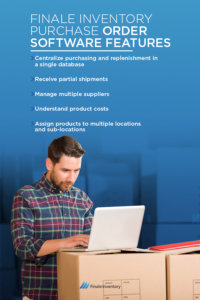How Purchase Ordering Works and Why Your Business Should Care: A Step-By-Step Process


If you’re looking for the newest technology solutions for purchase orders, see how Finale Inventory can automate your purchase orders. Creating purchase orders within Finale Inventory is intuitive and efficient.
What Is a Purchase Order?
A purchase order is a document generated by a company that wants to purchase goods or services from a supplier — in other words, the buyer. It serves as the official request and lists the terms, number of items and acceptable price points. The company sends it out, then the vendor either accepts, rejects or requests a change. Once the supplier agrees to a purchase order, it becomes legally binding. The company who sent it must pay an invoice for the agreed amount, and the vendor must fulfill the request.
A purchase order will list all the necessary information outlining the request. A purchase order will include:
- Purchasing organization name
- Purchase Order Number (PO number)
- Date
- Description and quantity of items
- Price
- Shipping address
- Mailing address
- Payment information
Review the video below to learn how to create a purchase order in Finale.
(Videos: See complete list of available videos)
When Is a Purchase Order Needed?
- Set expectations: As a purchaser, you can lay out your exact needs with your vendors. You’ll list the quantities you need and the price and shipping costs you expect to pay. You can express terms of the agreement as needed on the document. Both purchasers and companies can use it as evidence of the original deal if the shipment doesn’t meet expectations.
- Manage and track orders: Your procurement, finance and operations teams all need a reliable way to track orders and pending shipments. Official and standardized documentation speeds up communication, management and tracking. Without a standard procedure, you can end up digging through emails to find the terms and quantities of an order when someone needs them.
- Streamline budgeting: In general, you won’t pay your suppliers until you have confirmed receipt of the requested goods. Depending on the terms of your invoice, you may have up to a month or more to pay the invoice back to your vendor. It can get confusing to budget around the payments you expect to make later. With purchasing orders, you have documentation of the amounts owed, so you have accurate spending data. If you have software to manage purchase orders and other financials, these numbers can even update automatically.
- Create legally binding terms: Unless you have an official contract with a vendor, a purchase order acts as the legally binding document. Once a vendor accepts a purchase order from you, you are both bound by its terms.
- Track financial details: Purchasing orders create many advantages from a financial perspective. Many companies require approval before any purchase orders are sent, ensuring they have the budget for the purchase. The internal accounting team can use purchase orders to ensure the inventory order matches the amounts paid. Having POs and matching invoices creates a robust financial record and enables smooth auditing.
How Do Purchase Orders Work?
The purchase order procedure can vary depending on your company policy. No matter how your company sets them up and what information they include, creating them is easy with Finale Inventory. There are four steps in the purchase order process:
1. Create purchase requisition: First, a procurement specialist must get approval from the finance department. So, the buyer creates a document called a purchase requisition. Finance will either approve, deny or flag a request for further discussion. A requisition is not a purchase order. While a purchase requisition may have similar information, the document is used internally to get a purchase order approved before it is sent to the vendor.
2. Create purchase order: After the finance team approves a requisition, the buyer can create a purchase order to send to the supplier. It should include the billing address, shipping address, PO number associated with that order, the shipping date, product request, quantity, price and any other critical information to complete the order. The best way to create the order is by using software like Finale Inventory. When purchase orders are electronic, it makes the documents easier to track and automatically updates your inventory. When using Finale Inventory, the PO is sent to the email after you have completed a purchase order.
3. Vendor approves the request: The vendor can either accept, reject or submit the documents for further discussion. The supplier must ensure the price, quantity, total, terms and conditions are acceptable. When they approve, the order becomes legally binding, which is why it’s vital to start with a requisition before sending a purchase order. The vendor then begins preparing the order.
4. Receiving the order: When the shipment arrives, you can mark it “received” and update your inventory to match. Having a record can be helpful for accounting, auditing and general stock keeping. Finally, if the delivery meets your expectations, pay the supplier to complete the purchase order process.
Use Automated Purchase Ordering and Reporting to Prevent Overstocks and Backorders


Your assets are tied up in inventory, so having too much can be an issue, and having too little can affect your business. Backorders frustrate customers and deter them from shopping with you again. Overstocks result in aged inventory, which can hinder a brand’s reputation and growth. It often has to be sold at a clearance rate and takes up square footage that your company could otherwise dedicate to a product you can move.
Because of this, you must carefully plan purchasing orders so that inventory always arrives when you need it, in the amount that you need. Of course, vendors need a certain amount of lead time. Suppliers’ stock and pricing can vary, which can all affect their ability to fulfill your orders. Besides giving some leeway to the suppliers, you need a way to reliably predict when to reorder. You want to prevent running out of stock by replenishing inventory with an amount you’ll be able to move.
By creating purchasing orders through inventory management software, like Finale Inventory, you can set and calculate min/max thresholds to keep inventory on track. For each product in stock, you can set a reorder point, and when product dips below that number, your software will update you. You can also set the maximum number of products you want in stock after reordering. Finally, you can set the standard quantities your suppliers offer, such as cases of 50 units.
You can then automatically generate purchasing orders based on these numbers and send them to your preferred suppliers. Inventory tools can also predict your product needs. For example, if you sell specific products more in some months and fewer in others, you can stop or revise purchase orders when demand is low.
Handle Inventory With Inventory Management Software


When you use inventory management software, purchase orders become a record of the stock you can expect. In Finale Inventory, once you set a purchase order to “committed” status, your software will update your stock availability. Then, when the shipment arrives, you can receive it against the purchase order. Your in-stock number will automatically update to match. You can even receive partial deliveries of an order, so the inventory count will always be accurate.
With supplier information on record, the software can populate orders with the right information. Reporting tools will tell you what products need to be ordered and how many. They will contain a low-stock threshold for each type of merchandise, update within the software and email you when you need to reorder. It can calculate restocking needs across the entire store or department and trigger notifications for each item.
Plus, inventory management software allows you to calculate your sales velocity to understand how your stock moves and find emerging patterns. This data can help you adjust your settings for purchase orders, so you can order the right amount of inventory for the number of predicted sales.
When using software to organize purchase orders, it’s crucial to remember the factors that influence reordering. Always keep some safety stock on hand and give your supplier enough lead time to ensure products arrive before you run out. When you use software to handle inventory and reordering, you can generate purchase orders in a few clicks, so you can send them on time, every time.
Minimize Inventory Cost With an Efficient System
A purchase ordering system gives you a standardized record-keeping system. These documents tell you precisely what you ordered. Because they are legally binding, you can hold suppliers accountable when what arrives doesn’t match the request. Suppliers change their prices and shipping methods often and may send you the wrong amounts. When orders arrive, you can add inventory and import the supplier’s invoice into your software. Finale inventory can keep track of the cost, so you can hold suppliers accountable for errors.
Automating your purchase ordering can save you on inventory costs by saving time. An efficient system for generating purchase orders will save you time and money by:
- Centralizing purchase orders alongside vendor invoices and other documentation.
- Automating vendor catalogs to find goods and pricing quickly and pre-populate purchase orders.
- Expediting the internal requisition approvals process by generating total costs automatically.
- Streamlining communication about incoming shipments by making purchase orders easy to share.
- Visualizing your order status across your entire department or warehouse at a glance.
- Tracking purchase orders against goods received for up-to-date stock information and error reduction.
Use Purchase Orders for Financial Clarity
A complete record of stock intake, purchases and sales is crucial for accounting and auditing. Thus, recording purchase orders and the corresponding invoices is helpful. They create duplicate records to verify inventory levels and payments and allow the financial team to resolve discrepancies. Having your purchase orders automated reduces the chances for human error on your company’s end, creating fewer inconsistencies.
Suppliers change their prices often and use different shipment costs, tariffs, fees and rebates. These shifts make the value of your inventory change. Tracking how the total cost of your stock rises and falls is crucial for valuation purposes. Finale will calculate the landed cost based on the cost of the products themselves, plus any other costs you directly incur to obtain the products. These costs can include everything from shipping to tariffs to freight costs.
You’ll save time through automation, and keep accurate records for accounting purposes.
Further, you’ll get visibility into your spending. Through Finale Inventory’s integration with accounting software, you can update budgets and track spending automatically. So, when a purchase order goes through, you can see an overview of the amount you owe, giving you a better understanding of your budget, even before you pay the bills.
Finale Inventory’s Solutions
When you consider that every big business uses them, it’s easy to see why purchase orders help small businesses. Automating your purchase orders and the entire reordering process can have a time-saving impact on your business. Finale Inventory offers purchase orders within its inventory management solution. Our purchase ordering system will collect sales data from all your selling platforms and forecast sales to inform your restock decisions.
It collects your purchase orders and supplier information in a single, searchable location. You can manage multiple suppliers with ease and pull pricing, product details and contact information for each of your vendors. You can manage shipments to numerous locations and check your shipments against purchase orders, and even mark partial shipments when needed.
Contact Us for a Free Trial or Real-Time Demo
Finale Inventory is a world-class inventory management service with the most personalized customer experience. Our purchase order management solution is designed especially for inventory management and comes with all the features you need to track stock and calculate inventory costs. Contact us for a free trial or to schedule a free real-time demo.






